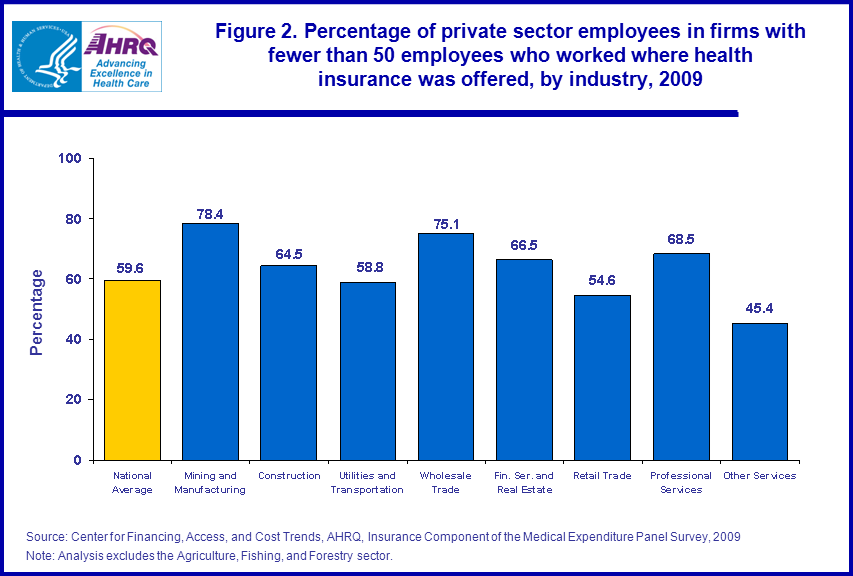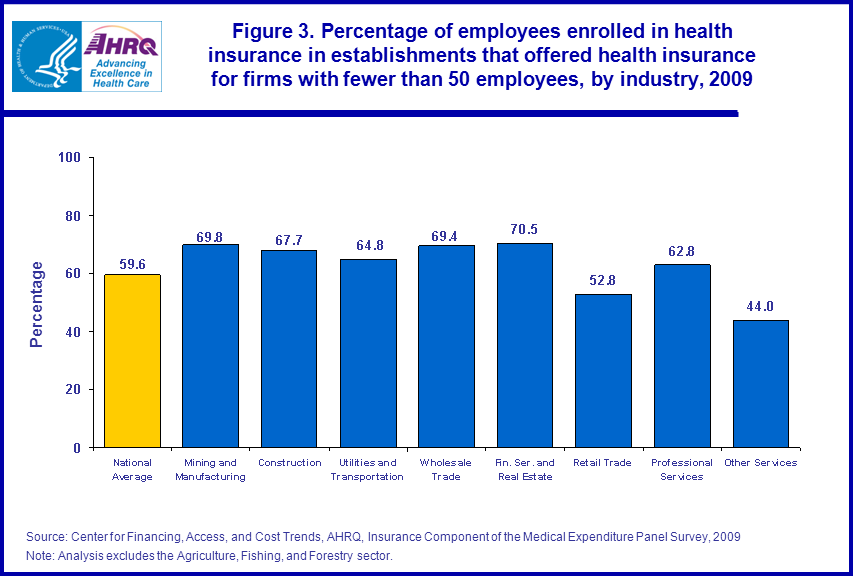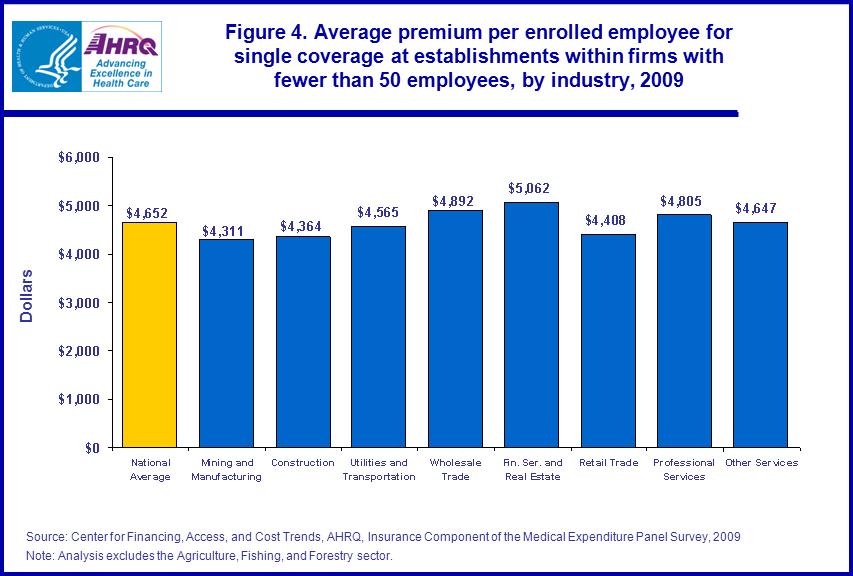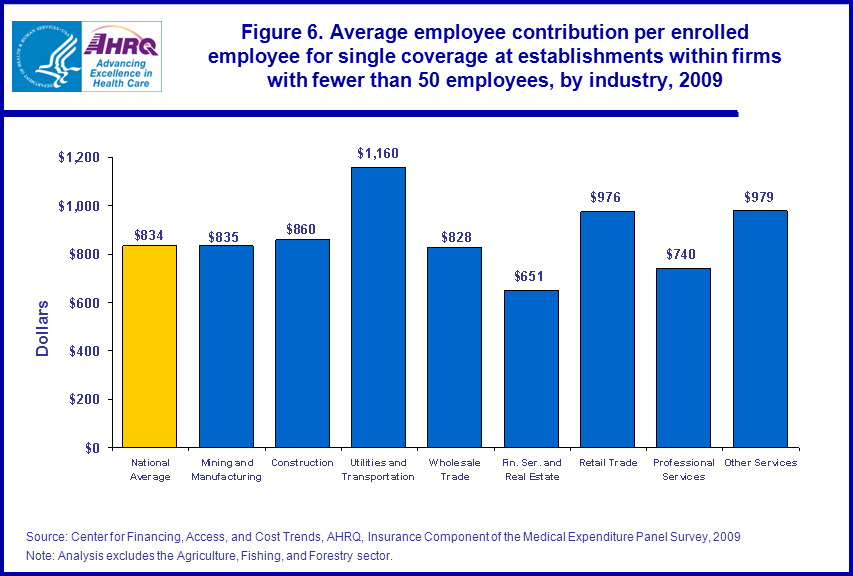
|
|
Font Size:
|
||||
|
|
|
|
||||
STATISTICAL BRIEF #321:
Employer-Sponsored Health Insurance for Small Employers in the Private Sector, by Industry Classification, 2009
Highlights
- In 2009, 59.6 percent of employees of small (fewer than 50 employees) private sector employers worked where health insurance was offered, with wide variations by industry.
- The percentage of private sector employees in small firms working where health insurance was offered ranged from 78.4 percent in the Mining and Manufacturing sector to 45.4 percent in the Other Services industry.
- Annual health insurance premiums per enrolled employee with single coverage at small firms averaged $4,652 in 2009. Premiums averaged $12,041 per enrolled employee for family-of-four coverage in small firms in the private sector.
- Average employee contributions for single coverage ranged from $1,160 in the Utilities and Transportation industry to $651 in the Financial Services and Real Estate sector for workers at small employers.
Introduction
Employer-sponsored health insurance for current workers is one of the primary sources of health insurance coverage in the United States. According to data from the Insurance Component of the 2009 Medical Expenditure Panel Survey (MEPS-IC), approximately 96.8 million of the 110.5 million employees from the private sector worked in firms where the employer offered health insurance. Of those employees who worked where health insurance was offered, approximately 59.1 million were enrolled. About 29.8 million employees (27 percent) worked for small private sector employers in 2009 across eight industry classifications (figure 1) and approximately 10.6 million of them were enrolled.This Statistical Brief presents estimates, by industry classification, on the percentage of employees who worked for small private employers (firms with fewer than 50 employees) who offered health insurance and of employees working in such firms who enrolled in offered health insurance plans. The Brief also provides estimates on average premiums and the average employee contributions towards premiums for single coverage and for family coverage. Only those estimates that had a statistically significant difference from the national average at the 0.05 percent significance level are noted in the text.
Although a large percentage of private sector employees worked where health insurance was offered in 2009, small private sector employers were much less likely to offer health insurance than other firms or governments. Among these small employers, the offer and enrollment rates varied considerably by industry.
Findings
Among the 29.8 million employees who worked for small private sector employers in 2009 (estimate not shown), 59.6 percent worked where the employer offered health insurance (figure 2). The offer rates varied considerably by industry classification. The percentage of employees who worked for small employers who offered health insurance was 78.4 percent for the combined Mining and Manufacturing sectors, 75.1 percent for the Wholesale Trade sector, 68.5 percent for the Professional Services sector, 66.5 percent for the Financial Services and Real Estate sector, and 64.5 for the Construction sector. All these rates were higher than the national average for small employers. Alternatively, the rates for the Other Services and Retail Trade sectors were lower than the national average for small employers, with only 45.4 and 54.6 percent, respectively, of employees in these small firms working where health insurance was offered.Annual health insurance premiums per enrolled employee with single coverage at small firms averaged $4,652 in 2009 (figure 4). Premiums averaged $12,041 per enrolled employee for family-of-four coverage (figure 5) in small firms in the private sector. The Financial Services and Real Estate and Professional Services industries had single premiums at small firms significantly higher than average at $5,062 and $4,805, respectively. Mining and Manufacturing and Retail Trade had below average single premiums at $4,311 and $4,408, respectively.
Average employee contributions towards premiums for small private sector employers in 2009 were $834 (figure 6) for single coverage and $3,630 (figure 7) for a family of four. Employee contributions toward single premiums were higher in the Other Services sector at $979. Alternatively, contributions toward single premiums were below average at $740 in the Professional Services sector and $651 in Financial Services and Real Estate. Employee contributions toward family premiums were higher in the Financial Services and Real Estate sector at $4,504.
Data Source
This Statistical Brief summarizes data from the 2009 MEPS-IC. The data are available on the MEPS Web site at http://www.meps.ahrq.gov/mepsweb/survey_comp/Insurance.jsp or have been produced using special computation runs on the confidential MEPS-IC data available at the U.S. Census Bureau.Definitions
In this Brief, an employer is defined as a private sector firm. A firm is defined as a business entity that controls one or more business establishments or locations. Consequently, an employer can have multiple work locations. Only small employers with fewer than 50 employees across all their locations were included in this analysis.The classification by industry is based upon the North American Industrial Classification System, available at http://www.census.gov/eos/www/naics/. Estimates for the Agriculture, Fishing, and Forestry sector have been excluded from this analysis.
About MEPS-IC
MEPS-IC is a survey of business establishments and governments that collects information on employer-sponsored health insurance, such as whether insurance is offered, enrollments, types of plans, and premiums. The survey is conducted annually by the U.S. Census Bureau under the sponsorship of the Agency of Healthcare Research and Quality. The yearly response rate has averaged 78 percent for in-scope sample units. Approximately 4 percent of the original sample has been out-of-scope in a typical year. A total sample of 42,000 establishments was selected for the 2009 survey, prior to accounting for losses due to nonresponse and out-of-scope cases.For more information on this survey, see MEPS Methodology Reports 6, 8, 10, 14, 17, and 18 under MEPS publications at http://www.meps.ahrq.gov/mepsweb/data_stats/publications.jsp and the MEPS Insurance/Employer Component Survey Basics at http://www.meps.ahrq.gov/mepsweb/survey_comp/Insurance.jsp.
Suggested Citation
Branscome, J. and Davis, K. Employer-Sponsored Health Insurance for Small Employers in the Private Sector, by Industry Classification, 2009. Statistical Brief #321. April 2011. Agency for Healthcare Research and Quality, Rockville, MD. http://www.meps.ahrq.gov/mepsweb/data_files/publications/st321/stat321.shtmlAHRQ welcomes questions and comments from readers of this publication who are interested in obtaining more information about access, cost, use, financing, and quality of health care in the United States. We also invite you to tell us how you are using this Statistical Brief and other MEPS data and tools and to share suggestions on how MEPS products might be enhanced to further meet your needs. Please e-mail us at mepspd@ahrq.gov or send a letter to the address below:
Steve B. Cohen, PhD, Director
Center for Financing, Access, and Cost Trends
Agency for Healthcare Research and Quality
540 Gaither Road
Rockville, MD 20850
 |
||||||||||||||||||||||||||||||||||||
|
||||||||||||||||||||||||||||||||||||
|
|
||||||||||||||||||||||||||||||||||||
 |
||||||||||||||||||||||||||||||||||||
|
||||||||||||||||||||||||||||||||||||
|
|
||||||||||||||||||||||||||||||||||||
 |
||||||||||||||||||||||||||||||||||||
|
||||||||||||||||||||||||||||||||||||
|
|
||||||||||||||||||||||||||||||||||||
 |
||||||||||||||||||||||||||||||||||||
|
||||||||||||||||||||||||||||||||||||
|
|
||||||||||||||||||||||||||||||||||||
 |
||||||||||||||||||||||||||||||||||||
|
||||||||||||||||||||||||||||||||||||
|
|
||||||||||||||||||||||||||||||||||||
 |
||||||||||||||||||||||||||||||||||||
|
||||||||||||||||||||||||||||||||||||
|
|
||||||||||||||||||||||||||||||||||||
 |
||||||||||||||||||||||||||||||||||||
|
||||||||||||||||||||||||||||||||||||
|
|
||||||||||||||||||||||||||||||||||||


